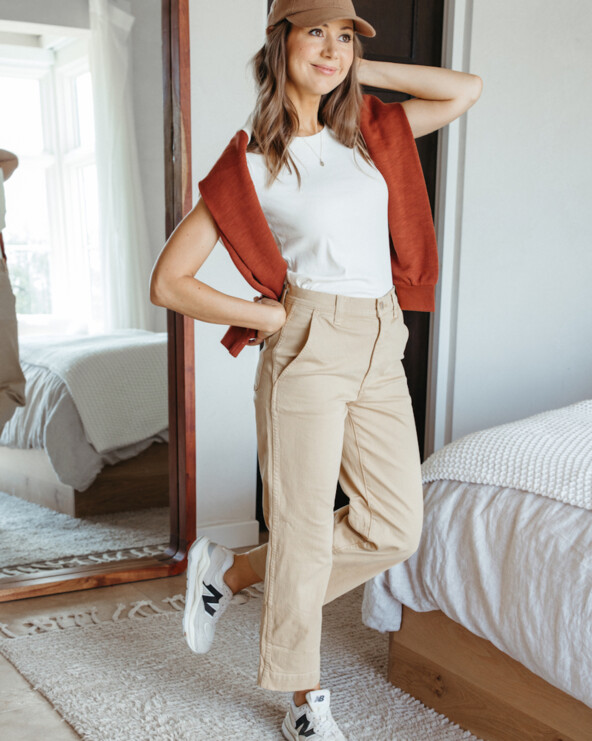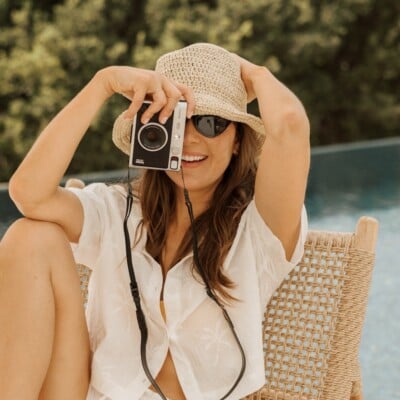I never thought a beauty tool could truly be “life-changing” until I met my magic brush. If you have thick tangle-prone hair like I do, you can probably relate to this: I used to spend ten frustrating, painful minutes a day combing through my hair after every shower. By the end of it my arms ached, my scalp hurt, and my brush was full of broken hair. I had tried so many types of brushes — round brushes, fine tooth combs (OUCH), soft brushes, paddle brushes — so when my stylist suggested the shower brush, I was fairly skeptical it would change much. I’ve never been happier to be wrong. After one easy comb-through in the shower, my hair was air-drying tangle free. It turns out there a plenty of tips and tricks that can make brushing your hair easier and more effective. So we got together with stylist Erica Rae to get the inside scoop on brushing, including which tools to use when and proper brushing technique.
photographed by jessica attie, modeled by laura dominguez, featured image via mane interest

Okay, so what’s the biggest mistake you see people make when it comes to brushing their hair?
Erica: Nothing makes me cringe more than seeing breakage caused by bad brush technique. Always brush your hair starting from the ends and work your way up to the scalp. When you begin brushing a section of hair, use your free hand to anchor the section so that you’re not pulling the hair from the scalp with each stroke. If you are tangle-prone, this can save you a lot of pain! Each head of hair is different and some have stronger strands of hair than others. For people with finer hair, be gentle. There’s nothing worse than unnecessary breakage.

Tell us a bit about the different types of brushes and who should use which kind:
There are so many different types of brushes on the market. You have your typical flat paddle brush which I would say is the most common and easiest to use for all hair types. They help give more shine and smoothness, although you can’t get much volume using a paddle brush. Then you have your synthetic and boar bristle round or flat brushes. They even have brushes that have a mix of both synthetic and boar. The synthetic bristles make it easier to comb through thicker hair and the boar bristles are soft and so are great for fine hair. The boar bristles also help give more shine to your hair because they help distribute the natural oils from your scalp to your ends. I LOVE the combo bristle brushes. They are harder to find but try one if you spot one. The purpose of a round brush version is to add more volume and curl to your hair. Just don’t get it tangled in your hair!! I always recommend to dry your hair with just your hands until you get most of the moisture out before attempting to round brush. Also, take small sections while round brushing. I hear the stories from clients all the time about that time they tangled their hair in the brush. It makes me laugh every time because it happened to me as a child. Horrible!

Erica’s Brush Breakdown:
- Untangled by Kevin Murphy — great detangling product.
- Flat boar bristle brush — great for fine hair. Adds shine. Especially good for smoothing out ponytails and updos.
- Wet/”magic brush” — perfect for tender headed people or people with extra fine hair. Prevents breakage. Can be kept and used in the shower.
- Young Again Styling Oil by Kevin Murphy — great for smoothing frizz out and also great to add to tangled hair for that extra slip.
- Shimmer Shine by Kevin Murphy — also great for detangling extra thick hair and perfect for that extra shine after a blow out.
- Wide tooth comb — use to comb out hair when wet.

How should we brush our hair when it’s wet? Does that differ from when it’s dry?
Your hair is in its most fragile state when it’s wet so it’s always best to use a wide tooth comb or a “wet/magic” brush or a wide tooth comb when brushing your hair while it’s wet. Again — always start from the bottom and work your way up to the scalp.

Should we really be brushing our hair 100x a day, or is that just an old wives’ tale?
Total wives’ tale. Leave that chore for the 19th century woman! My hair is naturally curly, so I like the texture my hair gets when I let it do its own thing. I’m lucky if I brush my hair once a day. But people with fine hair might want to brush more often to keep their hair looking full instead of stringy. The only real benefit of brushing your hair comes from brushing from the scalp down. When you do this, you spread your natural oils through your cuticle which is really moisturizing for your hair. When doing so it’s best to use a natural boat bristle brush.

Any scalp-saving tips for brushing tangle-prone hair? asking for a friend…. 😉
Erica: I never understood those tender headed people but I surprisingly come across it more often than not in the salon. I can’t imagine the pain! If you are tender headed and you don’t own a Magic/wet bush then stop what you are doing now and order one ASAP. They changed my life as a stylist (and everyone that I have recommended them to.) Also, spray any kind of detangling spray or any kind of styling oil in your hair before attempting to brush your hair out. The oils help the hair slip easier and so you don’t have to brush your hair as hard.

Any tips for cleaning hair brushes?
Erica: Okay, nothing is grosser than seeing a brush that has enough hair in it to create a wig. Especially when there is build up of product as well. It’s really simple: I recommend cleaning your brushes at least once a week or two. I usually use a pen or something with a point to lift the hair away from the brush and then pull the hair out. You then want to use a small amount of shampoo to clean the product build up out, rinse it well and then just let it air dry or blow it dry. Don’t get caught with a dirty brush! You will be surprised at how much better your brush will work when it’s clean.




